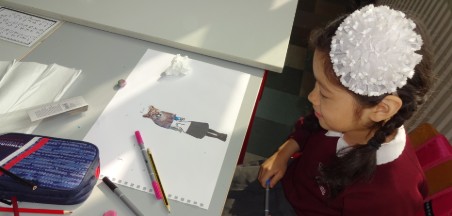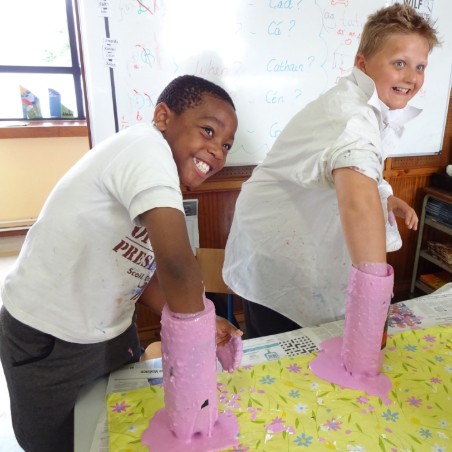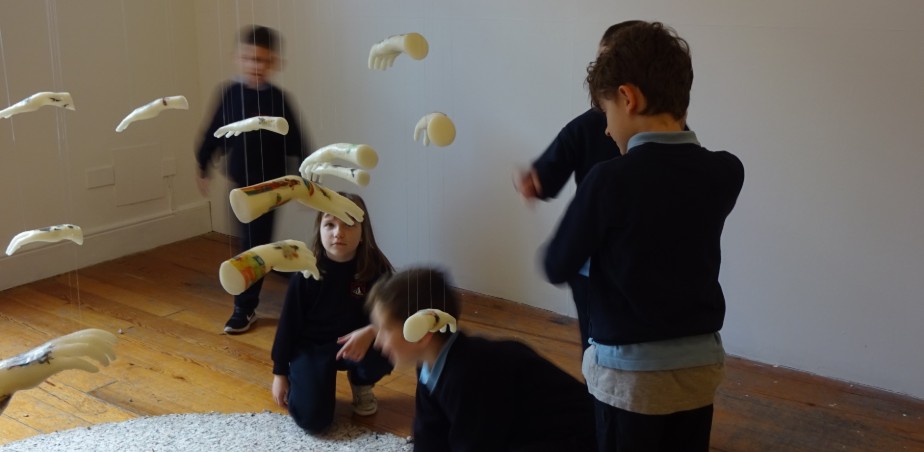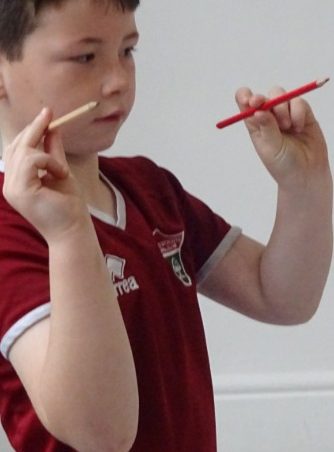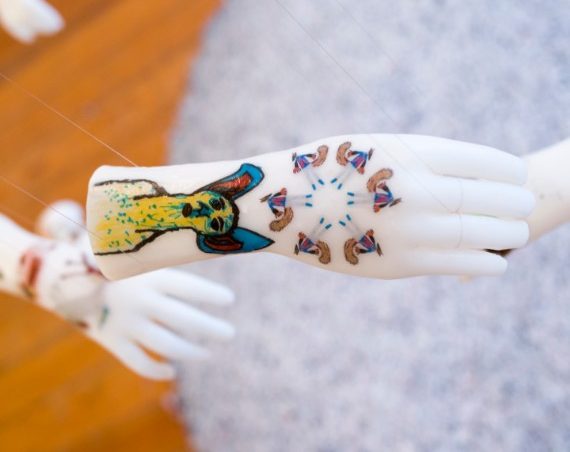Refine by Region
Refine by Art Form
Refine by School Level
Human Being and Human Becoming
Tell us the story of your project – What was the impetus? What was it about? Who was involved? How did you begin?
Initially in 2017, Cleo Fagan, curator of Superprojects, approached Maeve Mulrennan, curator of Galway Arts Centre about doing a project for children that explored the body and consciousness. Out of this conversation, the idea for working with the artist Siobhan McGibbon emerged, who had previously worked with young audiences as part of GAC’s Red Bird Collective. Siobhan’s work very much centres on the human body and she has extensive experience working with children and young people. Galway Arts Centre have worked with Scoil Chroí Íosa previously and the close proximity to GAC, combined with their enthusiasm for working on arts projects and the efforts and skills of the students themselves, made the school the ideal partner to work with.
Working over 9 sessions, Siobhan and the students have used collage and sculpture to explore transhuman themes, resulting in an exhibition (15th – 27th October 2018) in Galway Arts Centre for Baboró International Arts Festival for Children.
Siobhan McGibbon’s own practice combines arts practice, narrative and scientific research to imagine the future of the human species. In 2015 she created the world of the Xenothorpeans, a hybrid race of post-humans who were able to enhance their anatomy and genetic make-up with medical therapies. This fictional narrative evolved from research undertaken by her whilst on residency in the Centre for Research in Medical Devices (CÚRAM). Through the development of hybrid figures she articulates her hopes and fears concerning medical technology and the future of the human.
With this in mind, she has worked collaboratively with the pupils from Scoil Chroí to develop a speculative science fiction. This work was exhibited in Galway Arts Centre in October 2018. As a way to further expand on and explore the ideas in Siobhan and the children’s work, Education curator Katy Fitzpatrick and Professor of Education Aislinn O’Donnell worked with Siobhan to develop a series of creative, experiential workshops in response the exhibition at Galway Arts Centre. These were supported by the children-artists from Scoil Chroí Íosa who were joined by 2nd and 5th Class students from another local Galway school – Claddagh NS. The Art & Philosophy workshops developed an experimental range of exercises that were centred on the voice, ideas, experiences, and imaginations of children as they responded to work in the exhibition and the ideas provoked by that encounter.
How were the ideas developed and how did the young people, artist and teacher work together?
Siobhan McGibbon, Artist
As a starting point, I introduced the students to my practice. I talked about the origins of my ideas, explaining how I take inspiration from the biological sciences and use narrative and animal metaphors to think about what this research means. I told the class that a scientist would host a workshop about the regenerative capacity of sea animals and together we would respond to the science through storytelling.
In the initial stage, we talked about domestic animals and thought about the way dogs and cats live in the world. We thought about how these animals are similar and different to humans. As many of the students have cats and dogs as pets, they had lots to contribute. It was an accessible model to think about different ways of being in the world.
Following this, the scientist from CURAM hosted an interactive workshop, in which the students learnt about emerging science inspired by animal biology. The workshop involved lots of discussions, including all the students, class teacher Rachel and me. In the workshops after this, we thought about how this new science could change their lives. Through drawing and storytelling, we thought about the consequences of regeneration and immortality through speculative scenarios.
As the project developed, we explored case studies of more unusual animals that contribute to medical research, through a presentation of video clips, images and facts we thought about what life would be like if we were a hybrid of this animal. Each student explored this through drawing, collage and storytelling, which they presented it to the class. Following this, the class asked questions about the story and, together with teacher Rachel, we teased out the ideas that arose from these artworks. These group discussions led the workshops in new directions, new insights from each animal study contributed to the next, and in each workshop, we delved deeper into speculative ways being.
The Art and Philosophy Project involved working with Katy and Aislinn to respond to the rich and complex range of ideas and imagery that was generated through the school’s residency.
Education curator Katy Fitzpatrick and Professor of Education Aislinn O’Donnell
Through diverse arts-based, sensory, and philosophical methodologies, the children and their teachers: experienced the exhibition through a range of lens. These ranged from VTS and inquiry based philosophical approaches, considering the key concepts within the work, to children putting themselves imaginatively in the shoes of a chosen hybrid, generating choreographies to express that identity, engaging in sensation, touch and blind drawing exercises, debating whether it’s better to be a jellyfish that is immortal or a human who dies, and doing meditation exercises imagining the sensory experience of being starfish or a frog. The exercises supported a deeper engagement with the exhibition and opened up their imaginations and thinking. It was important to involve the children who had created the work in the school project, to describe their engagement in making the work, but also to co-facilitate and actively take part themselves, in particular in facilitating the philosophical conversations about ‘big questions’.
What was your personal experience of the project in terms of successes and challenges?
Cleo Fagan, Curator
I think Siobhan as an artist who has such an imaginative and research-based art practice, works really well in the primary educational context. Siobhan’s research includes the analysis of animal biology and behaviour and then makes big imaginative leaps that lead to strange but fascinating speculative conclusions. The way children think is highly imaginative and they often love the peculiar, so what better people to go on an artistic journey into the world of transhumanism! I think it’s very exciting to engage children in such a complex and rich area of research. Not only does Siobhan have these highly relevant research interests, but she also has strong interpersonal skills and a good sense of humour – very useful qualities for working with children.
The Art & Philosophy programme in Galway Arts Centre, worked with students from Claddagh NS, as well as some of the original Scoil Chroí Íosa students (co-creators of the exhibited artworks and in this instance they supported in a co-facilitation role). This enquiry was another project in itself. The programme used a number of different learning methodologies, to provide students the opportunity to develop their own considered responses to the artworks, as well as the ensuing big ideas that led from this process of engaging with the artworks. This excellent and intricate programme took the students on a dynamic intellectual and creative journey, a process that is well illustrated in the documentation film.
What was significant for you about the project that is worth sharing?
Siobhan McGibbon, Artist
‘Explorations of hybrid configurations from mythology to science fiction underpin my practice. I’m interested in the symbolism and metaphor embedded within the iconography and the hybrids endless mutability to think about ways of being in the world and alternative ways of being in the future.
This was the first time I explored this ‘framework for thinking’ with children. Each student created hybrids that embodied their ideas and speculations about the emerging science that they learnt in the workshop with the scientist.
I was amazed at how quickly the students grasped the concept and I was delighted by their dynamic hybrids. It was fascinating to listen to their science-fiction narratives, in which they placed their own experience at the centre and imagined the future. Each student had different approaches to thinking with their hybrids; some created hybrid languages while others thought about what it would be like to move with these re-configured anatomies.’
Has anything changed in your work as a result of the project?
Siobhan McGibbon, Artist
At the moment I am in a phase of Phd research, so until I go back into the studio I won’t know the answer to this!
Cleo Fagan, Curator
Yes, working in the combined classroom and gallery context has resulted in some insights on making work for the public, that I think may enhance future work in this area.
In reading research studies on art education over the years, it has come to my attention that children and young people can get more meaning from artmaking activities when they exhibit the resulting work in public. As mentioned, as part of the project, the children had their work exhibited in the main space at Galway Arts Centre, and they took evident pride in this. I believe that the Art & Philosophy programme further enhanced the meaningfulness for the participating children in having their work exhibited publicly, in that it allowed them to collectively and discursively investigate the potential experience of art for the viewer and the type of intellectual and creative journey that encountering an artwork can stimulate. The fact that some of the Scoil Chroi Iosa children had an active facilitation role with the children from Claddagh NS, was also significant.
The danger of working towards an outcome such as a public exhibition, is that the focus can be on the product, and not on the process. However, as Siobhan had 9 full sessions with the students in which to develop a significant creative enquiry, and perhaps because the children didn’t have clear ideas about what an art exhibition was, they remained engaged in the creative process in each session.
In my work as a curator, I would like to continue to work with this balance between quality of process, co-creation between artists and children, and public outcome.
Spotlight
Artist(s):
Siobhan McGibbon
http://www.siobhanmcgibbon.com/
In collaboration with Katy Fitzpatrick and Aislinn O’Donnell (Art & Philosophy in the Classroom)
Teacher(s):
Rachel Scott, Scoil Chroi Iosa
Rachel Scott is from Salthill, Galway. She studied Irish and Spanish in NUIG before completing her primary teaching degree in London with a modern foreign languages specialism which saw her travel to Spain to teach, before returning to Galway where she began working in Scoil Chroi Iosa. Rachel believes in an all-encompassing approach to teaching, with a focus on wellness. She loves to bring her students outside, to be active, and to learn about their city & to try new things.
Other:
(Curator, agency, etc):
Cleo Fagan, Superprojects
Cleo Fagan is the founder and director of Superprojects - an initiative for young audiences that generates possibilities for creative encounters with contemporary art and artists. Superprojects' work includes school-based workshop and artist-residency programmes, Per Cent for Art commissions, festival events and child-centred exhibition programmes that open up the richness of national and international contemporary art practice to child participants; whilst actively fostering their development as meaning-makers and artists. Recent projects include Elemental – an exhibition of contemporary sculpture, especially for children, with newly commissioned work by artist Caoimhe Kilfeather and existing work by artist Karl Burke, and creative response space designed and created by practising primary school teacher and trained artist Anne Bradley. Elemental was exhibited at Uillinn: West Cork Arts Centre from January – March 2019, with a collaborative commission of work by artist Siobhan McGibbon and a group of 3rd, 4th and 5th class children from Dromore National School in Bantry. Elemental will be exhibited in Visual, Carlow, from September 2019 – January 2020. As of September 2019, Cleo Fagan has taken up the role of Education Curator at The Hugh Lane Gallery in Dublin. The 2020 Superprojects programme will be run by curators Rayne Booth and Claire Power.
For more information on Superprojects please visit: www.superprojects.org
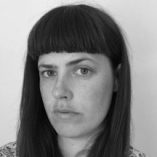
Artist(s)
Siobhan McGibbon

Teacher(s)
Rachel Scott
Artforms
School Level
School/
Participant Group
Scoil Chroí Íosa, Galway
No. Participants
24
Region
Age/Class
6 to 10 years old
Dates
April – May 2018 and October 2018
Weblinks
Leading Agency
Superprojects
Other Partners and/or Funders
Galway Arts Centre, Galway, Baboró International Arts Festival for Children
Key themes/ lines of enquiry
Exploring imaginative future possibilities for the human body, creating science fiction based on science fact.
Curriculum Strands
Art, English, Social, Environmental and Scientific Education, Social Personal and Health Education Curriculum, Physical Education (for the Art & Philosophy programme), Religious Education (for the Art & Philosophy programme)
The way children think is highly imaginative and they often love the peculiar, so what better people to go on an artistic journey into the world of transhumanism!
Cleo Fagan, Curator

